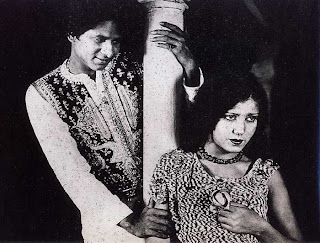Celebrating 100 years of Indian cinema
A Potpourri of Vestiges Guest PostBy Sanjeev Kumar
 |
| A Still from Dadasaheb Phalke's Raja Harishchandra |
May, 1913 saw the release of the first epochal film in Indian cinema. The film was “Raja Harishchandra” in Marathi language, and it was directed and produced by Dadasaheb Phalke, also noted as the Father of Indian Cinema. Fast forward to 2013 and we have films like “Barfi!”, written and directed by Anurag Basu, another eminent director of his own legion. From silent films to 3D entertainment, Indian cinemas continue to thrill. In this article, we will see the evolution of Indian cinema through various phases.
- The Silent Age
After
Raja Harishchandra movie, several other filmmakers joined the bandwagon and
continued to create silent films till 1931. From 1913 to 1931, we see Madras
rising as the center of Indian film industry, followed by Bombay (now Mumbai).
The time produced eminent film producers like SS Vasa and Raghupati Venkaiah
Naidu. In 1927, the Indian Cinematograph Enquiry Committee (ICC) was created by
the British Government to promote British films in India more than the American
ones.
 |
| A Still from thefirst Indian talkie Alam Ara |
- The Musical Talkie Era
On
14 March 1931, the first talking Indian film was released in the name of “Alam Ara” by Ardeshir Irani. The film surpassed all expectation and the next
couple of years saw movies like “Bhakta Prahlada”, “Jamai Shashthi”, “Kalidas”,
“Dev Devyani” and “Indra Sabha”.
It
was during this time that film actors realized that acting could become a great
way to make comfortable living. Song and dance sequences emerged. This era is
also known as “musical era” because actors were expected to sing their own
songs. Films were mostly being made in Tamil, Telugu, Bengali and Hindi
language.
This
age was also notable because for the first time ever, an Indian film was
screened at the Venice Film Festival. The film was the 1936 movie “Sant
Tukaram”.
 |
| A Still from Do Bigha Zameen |
- Turbulent 1940s to 1960s
The
1940s was the time of Second World War and Indian Independence struggle was in
full swing. The impact of the social and political surroundings could be seen
in the films too. The landmark film of the 1940s was “Kismet”, starring Ashok
Kumar. It dealt with unconventional issues like unmarried pregnancy and the
concept of anti-hero. The music industry grew by leaps and bounds with
lyricists and singers like SD Burman, Shankar Jaikishan, OP Nayyar, Madan
Mohan, Salil Chaudhury and Naushad.
Films
in India were made in multiple languages more than ever. The era saw the coming
of quintessential filmmakers like Raj Kapoor, Bimal Roy, Shantaram, Satyajit
Ray, K Asif, Mehboob Khan, Ritwik Ghatak, Ramu Kariatm, Mrinal Sen, Mani Kaul,
Buddhadeb Dasgupta, Guru Dutt, KV Reddy, LV Prasad, Sivaji Ganesan, NT Rama
Rao, Prem Nazir and Rajkumar.
Some
of the memorable films of these decades are “The Apu Trilogy” by
Satyajit Ray, “Neecha Nagar” by Chetan Anand, “Nagarik” by Ritwik
Ghatak and “Do Bigha Zameen” by Bimal Roy.
 |
| A Still from 36 Chowringhee Lane |
- Social Changes of '70s and '80s
If
the earlier decades were the Golden Age, the next two decades brought in
sweeping social changes that changed the way Indian film industry was working.
Various social and economic changes could be felt in filmmaking. The content of
films, the characterization and the narrative style change a lot.
The
trend was to produce “masala” films because of its instant entertainment value.
The patrons of the “masala” film genre were Amitabh Bachchan, Jeetendra, Vinod
Khanna, Rajesh Khanna, Dev Anand, Nargis, Waheeda Rehman, Sridevi, Smita Patil,
Sharmila Tagore, Hema Malini, Rekha and many more.
The
decades were also important for parallel cinema, also known as arty flicks. Films
like “Arth”,
“Paroma”, “Sparsh”, “Ek Pal”, “Salaam Bombay!”, “36 Chowringhee Lane” and
“Chashme Buddoor” were symbolic of these times. Aravindan, Adoor Gopalakrishnan,
Shaji Karun, Ritwik Ghatak, Shyam Benegal and Satyajit Ray were the prominent
directors of Indian art cinema.
 |
| A Still from LSD aka Love Sex Dhokha |
- The '90s to Recent Times
The
advancement in sound technology, choreography and technological special effects
paved the way to bring Indian cinema onto a global platform like we see today.
The 90s were a time when corporate world was slowly making headway into the
film industry as producers.
The
era saw films in horror, mystery, comedy, action, thriller and romantic genres.
The actors and actresses became “celebrities” enjoying stardom like never
before. From conventional and time-tested movie plots, we moved on to the burlesque,
queer, experimental and innovative films like “Udaan”, “Guzaarish”, “LSD”,
“Pan Singh Tomar”, "Gangs of Wasseypur" and others.
The
Bollywood film industry has become an intrinsic part of the global film
heritage. Our films are screened at international film festivals and foreign
film makers are showing a heightened interest in the Indian cinema. We also
have a sizable overseas market contributing to the Indian film industry
revenue.
The
Indian film industry has come a long way from the first silent film and it has
a long way to go.
About Author -
This guest post is written by Mr. Sanjeev Kumar, an avid movie buff and part of Movieplus.com. He loves to write on Hollywood & Bollywood Movies, Celebrities News, Gossips, etc. Find him on Google +.
Readers, please feel free to share your opinion by leaving your comments. As always your feedback is highly appreciated!
Complete List of Reviews
Previous Review: The Brave (1997)
Next Post: "Mamaiji" (Grandmother): A Short Film by Oorvazi
Previous Review: The Brave (1997)
Next Post: "Mamaiji" (Grandmother): A Short Film by Oorvazi
People who liked this also liked...



0 comments:
Post a Comment
Thanks for sharing for valuable opinion. We would be delighted to have you back.